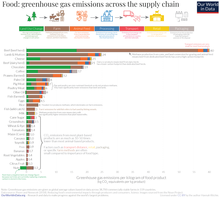
A carbon footprint (or greenhouse gas footprint) is a calculated value or index that makes it possible to compare the total amount of greenhouse gases that an activity, product, company or country adds to the atmosphere. Carbon footprints are usually reported in tonnes of emissions (CO2-equivalent) per unit of comparison. Such units can be for example tonnes CO2-eq per year, per kilogram of protein for consumption, per kilometer travelled, per piece of clothing and so forth. A product's carbon footprint includes the emissions for the entire life cycle. These run from the production along the supply chain to its final consumption and disposal.
Similarly, an organization's carbon footprint includes the direct as well as the indirect emissions that it causes. The Greenhouse Gas Protocol (for carbon accounting of organizations) calls these Scope 1, 2 and 3 emissions. There are several methodologies and online tools to calculate the carbon footprint. They depend on whether the focus is on a country, organization, product or individual person. For example, the carbon footprint of a product could help consumers decide which product to buy if they want to be climate aware. For climate change mitigation activities, the carbon footprint can help distinguish those economic activities with a high footprint from those with a low footprint. So the carbon footprint concept allows everyone to make comparisons between the climate impacts of individuals, products, companies and countries. It also helps people devise strategies and priorities for reducing the carbon footprint.
The carbon dioxide equivalent (CO2eq) emissions per unit of comparison is a suitable way to express a carbon footprint. This sums up all the greenhouse gas emissions. It includes all greenhouse gases, not just carbon dioxide. And it looks at emissions from economic activities, events, organizations and services.[2] In some definitions, only the carbon dioxide emissions are taken into account. These do not include other greenhouse gases, such as methane and nitrous oxide.[3]
Various methods to calculate the carbon footprint exist, and these may differ somewhat for different entities. For organizations it is common practice to use the Greenhouse Gas Protocol. It includes three carbon emission scopes. Scope 1 refers to direct carbon emissions. Scope 2 and 3 refer to indirect carbon emissions. Scope 3 emissions are those indirect emissions that result from the activities of an organization but come from sources which they do not own or control.[4]
For countries it is common to use consumption-based emissions accounting to calculate their carbon footprint for a given year. Consumption-based accounting using input-output analysis backed by super-computing makes it possible to analyse global supply chains. Countries also prepare national GHG inventories for the UNFCCC.[5][6] The GHG emissions listed in those national inventories are only from activities in the country itself. This approach is called territorial-based accounting or production-based accounting. It does not take into account production of goods and services imported on behalf of residents. Consumption-based accounting does reflect emissions from goods and services imported from other countries.
Consumption-based accounting is therefore more comprehensive. This comprehensive carbon footprint reporting including Scope 3 emissions deals with gaps in current systems. Countries' GHG inventories for the UNFCCC do not include international transport.[7] Comprehensive carbon footprint reporting looks at the final demand for emissions, to where the consumption of the goods and services takes place.[8]
- ^ Ritchie, Hannah; Roser, Max (18 March 2024). "You want to reduce the carbon footprint of your food? Focus on what you eat, not whether your food is local". Our World in Data.
- ^ "What is a carbon footprint". www.conservation.org. Retrieved 28 May 2023.
- ^ IPCC, 2022: Annex I: Glossary Archived 13 March 2023 at the Wayback Machine [van Diemen, R., J.B.R. Matthews, V. Möller, J.S. Fuglestvedt, V. Masson-Delmotte, C. Méndez, A. Reisinger, S. Semenov (eds)]. In IPCC, 2022: Climate Change 2022: Mitigation of Climate Change. Contribution of Working Group III to the Sixth Assessment Report of the Intergovernmental Panel on Climate Change Archived 2 August 2022 at the Wayback Machine [P.R. Shukla, J. Skea, R. Slade, A. Al Khourdajie, R. van Diemen, D. McCollum, M. Pathak, S. Some, P. Vyas, R. Fradera, M. Belkacemi, A. Hasija, G. Lisboa, S. Luz, J. Malley, (eds.)]. Cambridge University Press, Cambridge, UK and New York, NY, USA. doi:10.1017/9781009157926.020
- ^ Green Element Ltd., What is the Difference Between Scope 1, 2 and 3 Emissions? Archived 11 November 2020 at the Wayback Machine, published 2 November 2018, accessed 11 November 2020
- ^ Ritchie, Hannah; Roser, Max (18 March 2024). "How do CO2 emissions compare when we adjust for trade?". Our World in Data.
- ^ Cite error: The named reference
:20was invoked but never defined (see the help page). - ^ "Emissions from fuels used for international aviation and maritime transport". UNFCCC. Retrieved 11 June 2023.
- ^ Tukker, Arnold; Pollitt, Hector; Henkemans, Maurits (22 April 2020). "Consumption-based carbon accounting: sense and sensibility". Climate Policy. 20 (sup1): S1–S13. Bibcode:2020CliPo..20S...1T. doi:10.1080/14693062.2020.1728208. hdl:1887/3135062. ISSN 1469-3062. S2CID 214525354.